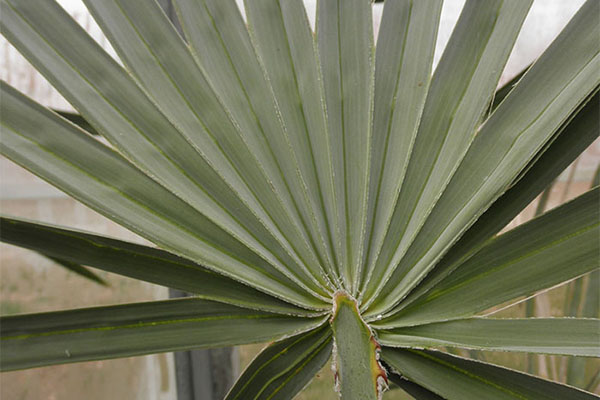Caranday Wax Palm

Copernicia alba
The slow growing Caranday, or Wax Palm, is an often overlooked member of the Copernicia family that can make a high impact both indoors and outdoors. The Wax Palm gets its name from the wax its leaves produce, which is commonly used in the cosmetics and automotive industries.
The Caranday Wax Palm has a tough, grey, cylindrical trunk that retains the spiky bases of old leaves for several years when the palm is young. These tough spines fall off as the palm matures, revealing a smooth bark. The foliage grows directly from the top of the trunk, forming a cascading fountain shape over time. These fronds are fan shaped, vary in shade from silver to light green or light blue, and can have sharp edges.
The Caranday Wax Palm flowers in the fall, with miniscule white flowers. These flowers produce round, yellow fruits that blacken as they ripen. These are edible, but are known to have a strong bitter taste after an initial sweetness.
This palm is gaining popularity due to its exceptional cold tolerance (withstanding temperatures of 25-30 degrees Fahrenheit), relative ease of maintenance, and resistance to pest and disease. Use it as a standalone focal point or in groupings of 2-3 for a standout specimen.

Ornamental Characteristics:
Native Origin:
South America, primarily Brazil, Bolivia, and Argentina
Common Names:
Wax Palm, Caranday Palm, Copernicia
Description:
Hardy Range: 9b- 11
Mature Height: 30-45’
Mature Spread: 10-15’
Growth Rate: Slow
Ornamental Characteristics:
Copernicia Alba have a grey-brown trunk that can grow up to 60’ high, though most never pass 40’. The foliage is stiff and fan shaped, with silver-green, green, or light silver-blue fronds. They produce inconspicuous white flowers in the fall, which bear small, edible, round, berry-like, juicy fruit in winter.
Environment:
Soil: Moist, well drained
Salt: Moderate
Exposure: Full sun, partial shade
Environment:
Salt: Moderate
Drought Tolerance: High
Exposure: Full Sun to Partial Shade



